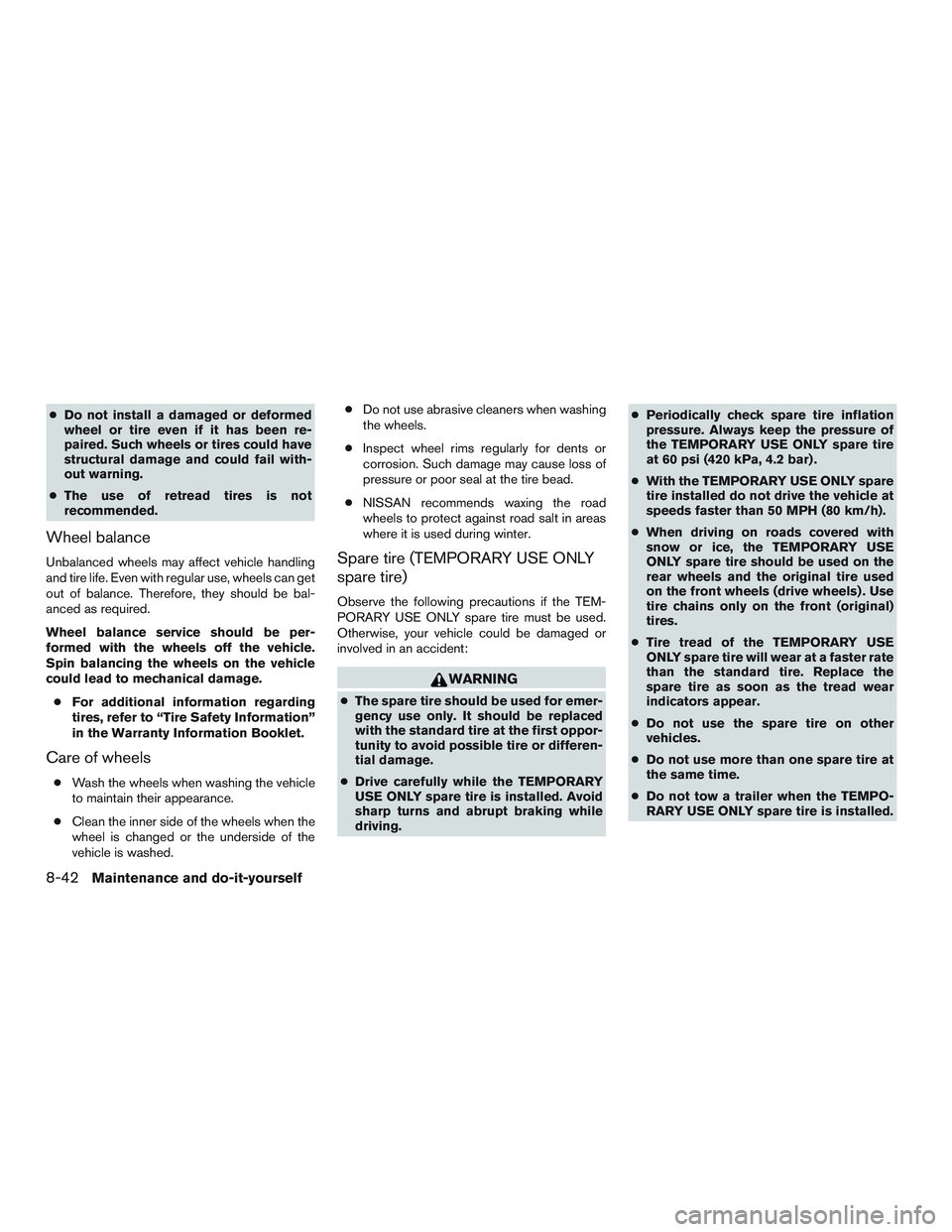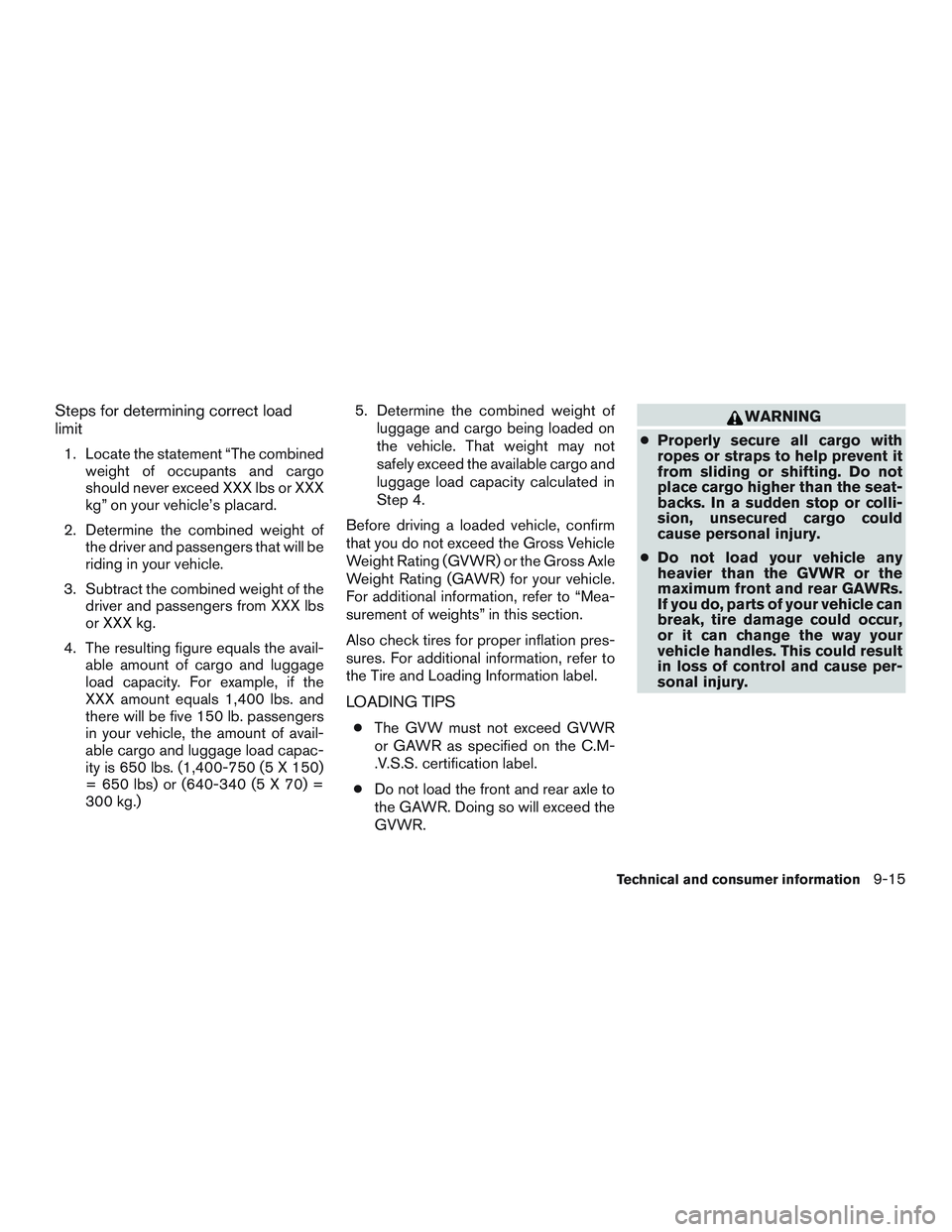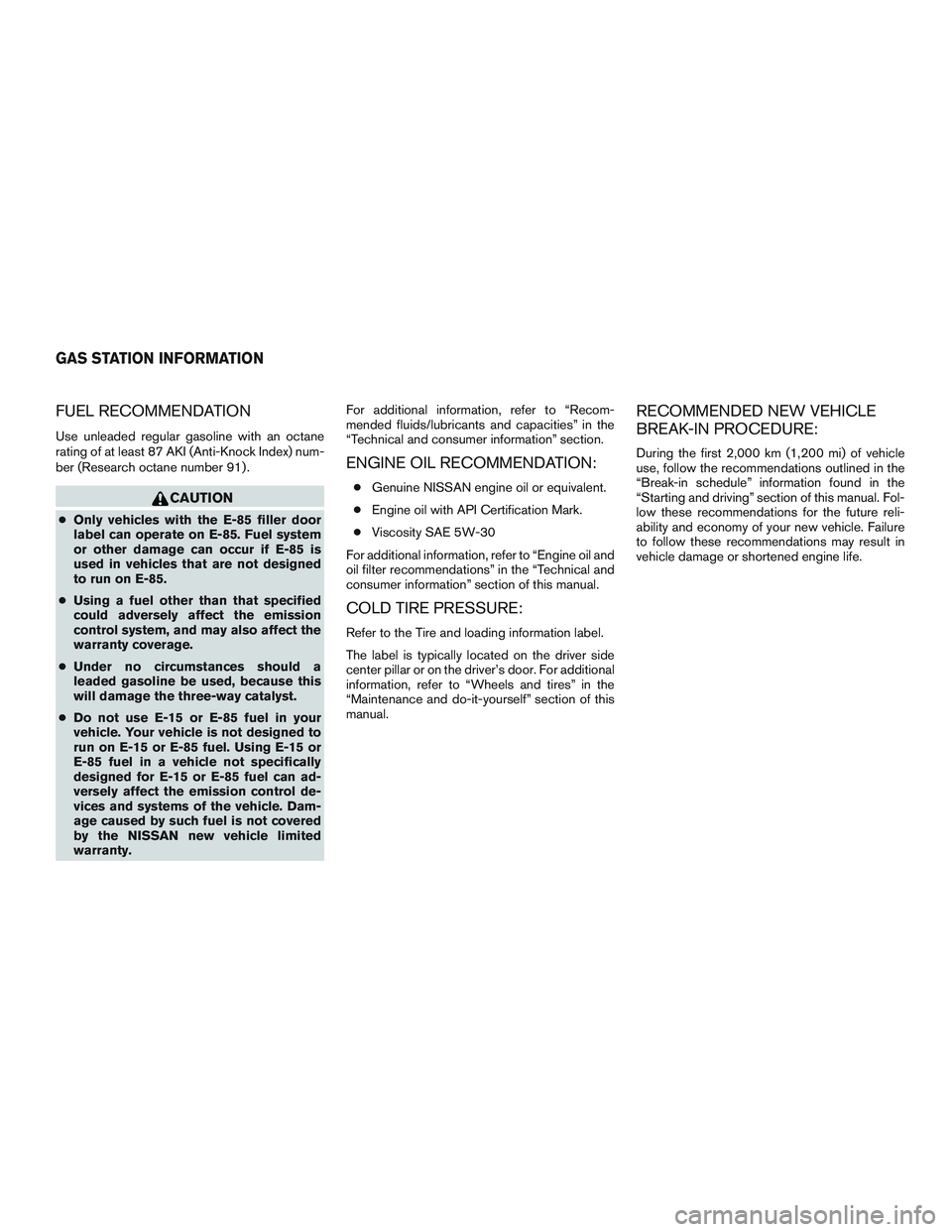2015 NISSAN MICRA tires
[x] Cancel search: tiresPage 263 of 293

●Do not install a damaged or deformed
wheel or tire even if it has been re-
paired. Such wheels or tires could have
structural damage and could fail with-
out warning.
● The use of retread tires is not
recommended.
Wheel balance
Unbalanced wheels may affect vehicle handling
and tire life. Even with regular use, wheels can get
out of balance. Therefore, they should be bal-
anced as required.
Wheel balance service should be per-
formed with the wheels off the vehicle.
Spin balancing the wheels on the vehicle
could lead to mechanical damage.
● For additional information regarding
tires, refer to “Tire Safety Information”
in the Warranty Information Booklet.
Care of wheels
● Wash the wheels when washing the vehicle
to maintain their appearance.
● Clean the inner side of the wheels when the
wheel is changed or the underside of the
vehicle is washed. ●
Do not use abrasive cleaners when washing
the wheels.
● Inspect wheel rims regularly for dents or
corrosion. Such damage may cause loss of
pressure or poor seal at the tire bead.
● NISSAN recommends waxing the road
wheels to protect against road salt in areas
where it is used during winter.
Spare tire (TEMPORARY USE ONLY
spare tire)
Observe the following precautions if the TEM-
PORARY USE ONLY spare tire must be used.
Otherwise, your vehicle could be damaged or
involved in an accident:
WARNING
● The spare tire should be used for emer-
gency use only. It should be replaced
with the standard tire at the first oppor-
tunity to avoid possible tire or differen-
tial damage.
● Drive carefully while the TEMPORARY
USE ONLY spare tire is installed. Avoid
sharp turns and abrupt braking while
driving. ●
Periodically check spare tire inflation
pressure. Always keep the pressure of
the TEMPORARY USE ONLY spare tire
at 60 psi (420 kPa, 4.2 bar) .
● With the TEMPORARY USE ONLY spare
tire installed do not drive the vehicle at
speeds faster than 50 MPH (80 km/h).
● When driving on roads covered with
snow or ice, the TEMPORARY USE
ONLY spare tire should be used on the
rear wheels and the original tire used
on the front wheels (drive wheels) . Use
tire chains only on the front (original)
tires.
● Tire tread of the TEMPORARY USE
ONLY spare tire will wear at a faster rate
than the standard tire. Replace the
spare tire as soon as the tread wear
indicators appear.
● Do not use the spare tire on other
vehicles.
● Do not use more than one spare tire at
the same time.
● Do not tow a trailer when the TEMPO-
RARY USE ONLY spare tire is installed.
8-42Maintenance and do-it-yourself
Page 266 of 293

9 Technical and consumer information
Recommended fluids/lubricants and capacities.......9-2
Fuel recommendation ...........................9-4
Engine oil and oil filter recommendations ..........9-6
Air conditioner system (if so equipped)
refrigerant and oil recommendations ..............9-7
Specifications .....................................9-8
Engine ........................................9-8
Wheels and tires ...............................9-9
Dimensions and weights ........................9-9
When traveling or registering your vehicle in
another country .................................. 9-10
Vehicle identification .............................. 9-10
Vehicle identification number (VIN) plate .........9-10
Vehicle identification number
(chassis number) .............................. 9-10
Engine serial number ........................... 9-11
C.M.V.S.S. certification label ....................9-11
Emission control information label ...............9-11Tire and loading information label
................9-12
Air conditioner specification label
(if so equipped) ............................... 9-12
Installing front license plate (if so equipped) .........9-12
Vehicle loading information ........................9-13
Terms ........................................ 9-13
Determining vehicle load capacity . . .............9-13
Loading tips .................................. 9-15
Measurement of weights .......................9-16
Towing a trailer ................................... 9-16
Flat towing .................................... 9-16
Uniform tire quality grading ........................9-17
Emission control system warranty ..................9-18
Reporting safety defects .......................... 9-18
Readiness for inspection/maintenance (I/M) test .....9-19
Event Data Recorders (EDR) .......................9-19
Owner’s Manual/Service Manual order information . . . 9-20
Page 274 of 293

WHEELS AND TIRES
Wheel typeSizeOffset mm (in)
Steel 15 x 5.5J50 (1.97)
Aluminum 15 x 5.5J
16x6.0J 50 (1.97)
55 (2.17)
Tire size 185/60R15
185/55R16
Spare tire T125/70D15
DIMENSIONS AND WEIGHTS
Unit: mm (in)
Body Type Hatchback
Overall length 3,827 (150.7)
Overall width 1,665 (65.6)
Overall height 1,527 (60.1)
Front Track
15 inch wheel 1,450 (57.5)
16 inch wheel 1,450 (57.5)
Rear Track
15 inch wheel 1,455 (57.7)
16 inch wheel 1,454 (57.3)
Wheelbase 2,450 (96.5)
Gross vehicle weight rating kg (lb)
Gross axle weight rating Refer to the “C.M.V.S.S. certifica-
tion label” on the center pillar be- tween the driver’s side front and rear doors.
Front kg (lb)
Rear kg (lb)
Technical and consumer information9-9
Page 280 of 293

Steps for determining correct load
limit
1. Locate the statement “The combinedweight of occupants and cargo
should never exceed XXX lbs or XXX
kg” on your vehicle’s placard.
2. Determine the combined weight of the driver and passengers that will be
riding in your vehicle.
3. Subtract the combined weight of the driver and passengers from XXX lbs
or XXX kg.
4. The resulting figure equals the avail- able amount of cargo and luggage
load capacity. For example, if the
XXX amount equals 1,400 lbs. and
there will be five 150 lb. passengers
in your vehicle, the amount of avail-
able cargo and luggage load capac-
ity is 650 lbs. (1,400-750 (5 X 150)
= 650 lbs) or (640-340 (5 X 70) =
300 kg.) 5. Determine the combined weight of
luggage and cargo being loaded on
the vehicle. That weight may not
safely exceed the available cargo and
luggage load capacity calculated in
Step 4.
Before driving a loaded vehicle, confirm
that you do not exceed the Gross Vehicle
Weight Rating (GVWR) or the Gross Axle
Weight Rating (GAWR) for your vehicle.
For additional information, refer to “Mea-
surement of weights” in this section.
Also check tires for proper inflation pres-
sures. For additional information, refer to
the Tire and Loading Information label.
LOADING TIPS
● The GVW must not exceed GVWR
or GAWR as specified on the C.M-
.V.S.S. certification label.
● Do not load the front and rear axle to
the GAWR. Doing so will exceed the
GVWR.
WARNING
● Properly secure all cargo with
ropes or straps to help prevent it
from sliding or shifting. Do not
place cargo higher than the seat-
backs. In a sudden stop or colli-
sion, unsecured cargo could
cause personal injury.
● Do not load your vehicle any
heavier than the GVWR or the
maximum front and rear GAWRs.
If you do, parts of your vehicle can
break, tire damage could occur,
or it can change the way your
vehicle handles. This could result
in loss of control and cause per-
sonal injury.
Technical and consumer information9-15
Page 282 of 293

DOT (Department of Transportation) Quality
Grades: All passenger car tires must conform to
federal safety requirements in addition to these
grades.
Quality grades can be found where applicable on
the tire sidewall between tread shoulder and
maximum section width. For example:
Treadwear 200 Traction AA Temperature A
Treadwear
The treadwear grade is a comparative rating
based on the wear rate of the tire when tested
under controlled conditions on a specified gov-
ernment test course. For example, a tire graded
150 would wear one and one-half (1 1/2) times
as well on the government course as a tire graded
100. The relative performance of tires depends
upon the actual conditions of their use, however,
and may depart significantly from the norm due to
variations in driving habits, service practices and
differences in road characteristics and climate.
Traction AA, A, B and C
The traction grades, from highest to lowest, are
AA, A, B, and C. Those grades represent the
tire’s ability to stop on wet pavement as mea-
sured under controlled conditions on specified
government test surfaces of asphalt and con-
crete. A tire marked C may have poor traction
performance.WARNING
The traction grade assigned to this tire is
based on straight-ahead braking traction
tests, and does not include acceleration,
cornering, hydroplaning, or peak traction
characteristics.
Temperature A, B and C
The temperature grades are A (the highest) , B,
and C, representing the tire’s resistance to the
generation of heat, and its ability to dissipate heat
when tested under controlled conditions on a
specified indoor laboratory test wheel. Sustained
high temperature can cause the material of the
tire to degenerate and reduce tire life, and exces-
sive temperature can lead to sudden tire failure.
The grade C corresponds to a level of perfor-
mance which all passenger car tires must meet
under the Federal Motor Safety Standard No.
109. Grades B and A represent higher levels of
performance on the laboratory test wheel than
the minimum required by law.
WARNING
The temperature grade for this tire is es-
tablished for a tire that is properly inflated
and not overloaded. Excessive speed,
under-inflation, or excessive loading, ei-
ther separately or in combination, can
cause heat build-up and possible tire
failure.
UNIFORM TIRE QUALITY GRADING
Technical and consumer information9-17
Page 291 of 293

Theft (NISSAN vehicle immobilizer system) ,
engine start..............2-13,3-2,5-7
Three-way catalyst ................5-2
Tilting steering wheel ..............3-13
Tire Flat tire .....................6-2
Spare tire ................6-3,8-42
Tire and Loading Information label .....9-12
Tire chains ..................8-40
Tirepressure.................8-34
Tirerotation..................8-40
Types of tires .................8-39
Uniform tire quality grading .........9-17
Wheels and tires ...............8-34
Wheel/tire size .................9-9
Towing Flattowing..................9-16
Towtrucktowing...............6-13
Trailertowing.................9-16
Towing a trailer ..................9-16
Transmission Automatic transmission fluid (ATF) .....8-11
Driving with automatic transmission .....5-8
Driving with manual transmission ......5-12
Shiftselectorlockrelease..........5-11
Travel (See registering your vehicle in another
country) ......................9-10
Trip computer ...................2-5
Trip odometer ...................2-4
Turnsignalswitch................2-19
U
Uniform tire quality grading ...........9-17
USB interface ..................4-40 Audio file operation
.............4-41
V
Vanity mirror ...................3-14
Vehicle dimensions and weights .........9-9
Vehicle dynamic control (VDC) off switch . . .2-20
Vehicle dynamic control (VDC) system .....5-21
Vehicle Dynamic Control (VDC) system ....5-21
Vehicle identification ...............9-10
Vehicle identification number (VIN)
(Chassis number) ................9-10
Vehicle identification number (VIN) plate ....9-10
Vehicle immobilizer system ......2-13,3-2,5-7
Vehicle loading information ...........9-13
Vehicle recovery .................6-15
Vehicle security system .............2-13
Vehicle security system (NISSAN vehicle immobi-
lizer system) , engine start ......2-13,3-2,5-7
Ventilators .....................4-6
Visors.......................3-13
Voice Prompt Interrupt ..............4-49
W
Warning Air bag warning light .........1-55,2-10
Anti-lock brake warning light .........2-8
Battery charge warning light .........2-8
Brake warning light ..............2-8
Door open warning light ...........2-8
Engine oil pressure warning light .......2-8
Hazard warning flasher switch ........6-2
Low fuel warning light .............2-9Low windshield-washer fluid warning light..2-9
Passenger air bag and status light .....1-49
Seat belt warning light ............2-9
Supplemental air bag warning light. .1-55, 2-10
Vehicle security system ...........2-13
Warning/indicator lights and audible
reminders ...................2-7
Warning labels (for SRS) ..........1-54
Warning/indicator lights and audible
reminders .....................2-7
Audible reminders ...............2-7
Indicatorlights.................2-7
Warninglights.................2-7
Warninglights...................2-7
Washer switch Rear window wiper and washer
switches ...................2-16
Windshield wiper and washer switch . . .2-14
Weights(Seedimensionsandweights).....9-9
Wheels and tires .................8-34
Wheel/tire size ...................9-9
When traveling or registering your vehicle in
anothercountry .................9-10
Windows Locking passengers’ windows .......2-26
Manual windows ...............2-26
Power rear windows .............2-26
Power windows ...............2-24
Rear power windows ............2-26
Windshield-washer fluid .............8-13
Windshield wiper and washer switch .....2-14
Windshield wiper blades ............8-17
Wiper
Rear window wiper and washer switches. .2-16
Windshield wiper and washer switch . . .2-14
Wiperblades.................8-17
10-6
Page 292 of 293

FUEL RECOMMENDATION
Use unleaded regular gasoline with an octane
rating of at least 87 AKI (Anti-Knock Index) num-
ber (Research octane number 91) .
CAUTION
●Only vehicles with the E-85 filler door
label can operate on E-85. Fuel system
or other damage can occur if E-85 is
used in vehicles that are not designed
to run on E-85.
● Using a fuel other than that specified
could adversely affect the emission
control system, and may also affect the
warranty coverage.
● Under no circumstances should a
leaded gasoline be used, because this
will damage the three-way catalyst.
● Do not use E-15 or E-85 fuel in your
vehicle. Your vehicle is not designed to
run on E-15 or E-85 fuel. Using E-15 or
E-85 fuel in a vehicle not specifically
designed for E-15 or E-85 fuel can ad-
versely affect the emission control de-
vices and systems of the vehicle. Dam-
age caused by such fuel is not covered
by the NISSAN new vehicle limited
warranty. For additional information, refer to “Recom-
mended fluids/lubricants and capacities” in the
“Technical and consumer information” section.
ENGINE OIL RECOMMENDATION:
●
Genuine NISSAN engine oil or equivalent.
● Engine oil with API Certification Mark.
● Viscosity SAE 5W-30
For additional information, refer to “Engine oil and
oil filter recommendations” in the “Technical and
consumer information” section of this manual.
COLD TIRE PRESSURE:
Refer to the Tire and loading information label.
The label is typically located on the driver side
center pillar or on the driver’s door. For additional
information, refer to “Wheels and tires” in the
“Maintenance and do-it-yourself” section of this
manual.
RECOMMENDED NEW VEHICLE
BREAK-IN PROCEDURE:
During the first 2,000 km (1,200 mi) of vehicle
use, follow the recommendations outlined in the
“Break-in schedule” information found in the
“Starting and driving” section of this manual. Fol-
low these recommendations for the future reli-
ability and economy of your new vehicle. Failure
to follow these recommendations may result in
vehicle damage or shortened engine life.
GAS STATION INFORMATION